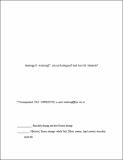Por favor, use este identificador para citar o enlazar a este item:
http://hdl.handle.net/10261/51557COMPARTIR / EXPORTAR:
 SHARE SHARE
 CORE
BASE CORE
BASE
|
|
| Visualizar otros formatos: MARC | Dublin Core | RDF | ORE | MODS | METS | DIDL | DATACITE | |

| Título: | Rancidity development during frozen storage of mackerel (Scomber scombrus): effect of catching season and commercial presentation |
Autor: | Aubourg, Santiago P. CSIC ORCID; Rodríguez, Alicia; Gallardo, José Manuel CSIC | Palabras clave: | Mackerel Frozen storage Whole fish Fillets Season Lipid content Rancidity Shelf life |
Fecha de publicación: | 2005 | Editor: | Wiley-VCH | Citación: | European Journal of Lipid Science and Technology 107(5): 316-323 (2005) | Resumen: | Hydrolytic and oxidative rancidity development and its effect on quality loss were studied in frozen mackerel (Scomber scombrus) by biochemical and sensory indices. The effect of the lipid content on fish damage at a commercial freezer temperature (−20 °C) was studied for up to 12 months; thus, mackerel caught at two different times of the year (May and November) was checked, May being the period of minimum lipid content, while November is known to be the time of maximum lipid content. The study was also focused on two different kinds of fish products (whole fish and fillets). Increasing lipid hydrolysis was observed for all kinds of samples during the frozen storage; no differences (p >0.05) between whole fish and fillets were found for free fatty acid formation; however, mackerel from May showed a higher (p <0.05) hydrolysis development than its counterpart from November. Increasing lipid oxidation (peroxide value and thiobarbituric acid index) was observed for all kinds of samples during the frozen storage. Fillet lipid oxidation was found to be higher (p <0.05) than in whole fish. Fattier mackerel (November fish) showed a higher (p <0.05) oxidation development than its counterpart from May in the case of fillet products. Results of fluorescence assessment, related to interaction compound formation, proved to be higher (p <0.05) in fillets than in whole fish, although they were higher (p <0.05) in May samples. Sensory analysis corroborated the biochemical analyses, so that fillets showed a shorter shelf life (1 and 3 months for November and May fish, respectively) than their whole fish counterparts (5 months for November and May mackerel). | Descripción: | 8 páginas, 3 tablas, 4 figuras | Versión del editor: | http://dx.doi.org/10.1002/ejlt.200401124 | URI: | http://hdl.handle.net/10261/51557 | DOI: | 10.1002/ejlt.200401124 | ISSN: | 1438-7697 | E-ISSN: | 1438-9312 |
| Aparece en las colecciones: | (IIM) Artículos |
Ficheros en este ítem:
| Fichero | Descripción | Tamaño | Formato | |
|---|---|---|---|---|
| Rancidity_development_during_mackerel.pdf | 343,3 kB | Adobe PDF |  Visualizar/Abrir |
CORE Recommender
SCOPUSTM
Citations
59
checked on 21-abr-2024
WEB OF SCIENCETM
Citations
56
checked on 18-feb-2024
Page view(s)
335
checked on 26-abr-2024
Download(s)
562
checked on 26-abr-2024
Google ScholarTM
Check
Altmetric
Altmetric
NOTA: Los ítems de Digital.CSIC están protegidos por copyright, con todos los derechos reservados, a menos que se indique lo contrario.
